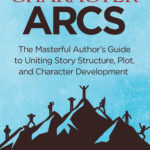 K.M. Weiland, author of historical and speculative fiction as well as books on the craft of writing, joins us from western Nebraska.
K.M. Weiland, author of historical and speculative fiction as well as books on the craft of writing, joins us from western Nebraska.
Thanks so much for joining us at The Westminster Confession of Funk. It is a real pleasure to be able to ask you a few questions about your work on Creating Character Arcs.
First, when you began systematizing what you knew about character arc, what was the most unexpected thing you learned?
For me, the crystallization of the thematic dichotomy between the Truth and the Lie the Character Believes is what suddenly made the concept of character arc click on an applicable level.
It was while working on Jane Eyre: A Writer’s Digest Annotated Classic and charting Jane’s Positive Change Arc—which is just so perfect and so powerful—that I gelled my own understanding of how inextricable plot and character are from one another. Character arcs and plot structure are intertwined at every beat of the story.
I can’t say it was unexpected, but it was explosively eye-opening.
How has your writing life and, specifically, your creative process changed from your first book to the present?
My process has refined itself into more and more of a preparation-focused approach. One thing I’ve realized over the years is that I love outlining and hate revising. Understanding that has allowed me to consciously emphasize (and de-emphasize) according to my strengths and weaknesses.
When I wrote my first book (as a teenager, almost twenty years ago now), I had much of the story “outlined” in my mind, but otherwise pretty much wrote it by the seat of my pants. These days, I outline as thoroughly as possibly can.
I find that plotting a story’s events and writing its narrative require two totally different skill sets—and two totally different parts of my brain. I like to get as much of the plotting and planning done before I start the first draft, leaving my brain completely free to just craft words in the drafting stage.
What would you suggest a greenhorn writer, who is just beginning to explore character arc, do to develop his own eye and ear for character arc?
Reading about the principles of arc, such as I teach in my writing books, is a good place to start, since it grounds the abstract nature of plot, character, and theme in more concrete terms.
But truly, the best way to internalize character arcs—to learn their power and flow by osmosis—is to study them in your favorite books and movies. As I mentioned, for me, studying Charlotte Bronte’s classic Jane Eyre, on a granular level, was one of the most instructive experiences I’ve ever had, particularly in regard to character arcs.
I know as I read Creating Character Arcs I couldn’t help but think of the arc of my own life. Have you had any surprising responses to your book on character arc?
Yes, I’ve had quite a few people—some even non-writers—tell me the book was transformational on a personal level. I know that has been true for me as well. I can’t help seeing my own life as anything less than series of character arcs (of all types!). Understanding that personal growth is largely an overcoming of lies in pursuit of truths has been wonderfully helpful for me in making sense of own life.
What would you say is the most important thing that you have learned about life as you have developed your craft as a novelist?
That life is story, and story is life.
So many of the narratives we take for granted, on so many levels, are really just stories. Except there’s no “just” about it. We both hark back to and build upon the archetypal narratives of our subconscious experiences, personal and human.
Being a storyteller—a good storyteller, at any rate—is a pursuit of life itself. It’s a sometimes frightening, often overwhelming, but always gratifying journey. I’m prejudiced perhaps, but I believe telling truthful stories is the most important thing any human ever does.
Do you have any upcoming projects you would like our readers to know about? And what is the best way for our readers to get your books?
My latest novel Wayfarer just came out. It’s a gaslamp fantasy that I think of as “Charles Dickens meets Spider-Man.” Currently, I’m working on sequels to my portal fantasy Dreamlander. I also have a couple new writing books in the cooker, a new outlining book and one that explores theme, both of which I hope to publish next year.
Katie, thanks so much for joining us at The Westminster Confession of Funk!
Pick up your copy of Creating Character Arcs today.

K.M. Weiland lives in make-believe worlds, talks to imaginary friends, and survives primarily on chocolate truffles and espresso. She is the award-winning and internationally-published author of Outlining Your Novel, Structuring Your Novel, and Creating Character Arcs. A native of western Nebraska, she writes historical and speculative fiction and mentors authors on her award-winning website Helping Writers Become Authors.
